Geological and Geotechnical Studies Aimed at the Project and Construction of Rockfill Recharge Dams: The Case Study of the Wadi Sulayf Dam, Wilayat Ibri Region, Oman
Abstract
1. Introduction
2. Geomorphological and Geological Setting
2.1. Dam Site Location and Storage Reservoir
2.2. Geological and Seismological Setting of Ibri Region
- Allochthonous units of the Hamrat Duru Group, belonging to the Hawasina Nappe. In particular, deposits belonging to three distinct formations are presents: (i) shallow-water packstone (Gw) of the Guwayza Fm., Middle–Upper Jurassic in age; (ii) open-marine deposits consisting of mudstone with chert nodules and turbiditic wackestone/packstone with cherts of the Sid’r Fm. (Si), late Tithonian to early–middle Cenomanian in age; (iii) open-shelf to distal open-marine deposits of the Wahrah Fm., represented by whachestone/packstone, mudstones and cherts, and cherts with silicified mudstones (Wa), Middle Jurassic to Turonian in age.
- Post-Nappe autochthonous units represented by inner to outer marine platform deposits, late Paleocene to early Eocene in age. They include yellow mudstones (e1aLM3), massive nodular mudstone/wackestone (e1bL), and bedded packstone/grainstone (e1bL1).
- Quaternary continental deposits, including (i) ancient (Qgx) and sub-recent (Qgy) alluvial fans and terraces; (ii) khabra deposits consisting of silts and clays (Qky-z); (iii) recent to sub-recent eolian sands (Qsy-z); (iv) recent alluvial deposits of wadis (Qtgz).
3. Materials and Methods
3.1. Feasibility Study and Detailed Design Phase
3.1.1. Recharge Dam Selection Criteria
- Local people request and presence of Aflaj.
- Catchment size: A large catchment basin is able to collect the volume of water in the recharge area. The fundamental principle of the identification is to identify dam sites that could perform the magnification of aquifer recharge in the indicated catchments and in the sub-catchment; the most promising situation is where the morphology shows a narrowing of the valley, with the consequent, presumable concentration of transit of groundwater avoiding the recharge dispersion in a too-large aquifer system [39]. This condition should optimize the piezometric elevation, creating better conditions for recovery of Aflaj systems or wells.
- The availability of alluvial deposit, holding the dam, which should possibly be constituted by permeable coarse sediments (gravel and sand) that allow the quick infiltration to the aquifer without interruption by low transmissivity layers as silty, clayey, or cemented ones.
- The retention basin location should be upstream of the villages. The reservoir and dam extension should not take away from areas planned for more relevant developments. Furthermore, the submergence of houses must be avoided and the temporary submergence of any roads and crops must be reduced to a minimum.
- Local dam functionality, guaranteeing adequate temporary retention capacity and sufficient drainage area extension.
- Economical aspects for a dam approximately 8–10 m high.
3.1.2. On-Site Surveys
- Four vertical boreholes with continuous coring (location in Figure 4);
- Rock Quality Designation (RQD) determined according to Deere and Deere [40];
- Eight Standard Penetration Tests (SPTs), carried out during drillings in accordance with BS 1377-9 [41];
- Four permeability tests along the boreholes, consisting of three packer permeability tests and two falling head permeability tests, in accordance with BS 5930 [42];
- Installation of one standpipe piezometer along borehole BH-01;
- Collection of 6 bulk and disturbed samples from the core drilling boxes;
- Twelve trial pits within the reservoir area of the proposed dam, with depths ranging from 0.60 m to 2.50 m b.g.l. (location in Figure 4);
- Two infiltration/percolation tests performed inside the trial pits in accordance with BS 6297 [43].
3.1.3. Laboratory Tests
3.1.4. Geotechnical and Hydraulic Design
3.2. Supervision Phase
4. Results
4.1. Geological Setting of the Dam Site
4.2. Geotechnical Characterization of Foundations and Construction Materials
- Alluvial Deposit (ALL);
- Conglomerate (CG);
- Marl (M);
- Limestone (L).
4.2.1. Alluvial Deposit (ALL)
4.2.2. Conglomerate (CG)
4.2.3. Marl (M)
4.2.4. Limestone (L)
4.2.5. Construction Materials
4.2.6. Geotechnical Design Parameters
4.3. Geotechnical Design of the Dam Embankment
4.3.1. Internal Erosion and Dam Slope Protection
4.3.2. Seepage and Filtration
- Initial steady state: Long term steady-state conditions with the reservoir at its normal retention level (full supply level—FSL) and the tail water at the ground surface;
- Transient analysis: Drawdown from normal retention level (FSL) to the lowest draw down level;
- Post-drawndown stability: Multiple time step stability analysis after drawdown.
4.3.3. Slope Stability
5. Discussion
5.1. Final Choice of the Dam Site
- Hydrological aspects: The potential aquifer storage is estimated to be about 1,300,000 m3 [82].
- Geological survey results: (i) Presence of an alluvial body (sandy gravel, ~10 m thick) with medium–high permeability; (ii) occurrence of fractured sedimentary hard rock (Conglomerates, 5–12 m thick) with water circulation through fractures; (iii) emergence of bedrock at morphological thresholds, where the valley narrows and enhances aquifer flow concentration, as evidenced by agricultural activities and settlements; (iv) sedimentary rocks is less fractured and virtually waterproof (aquicludes).
- Hydrogeological setting: The water table is often located within the fractured rock mass.
- Hydrological function of the dam: Capable of collecting water from flash floods that occur in wadi systems in arid areas, such as Wadi Sulayf, in order to augment limited water resources [16]
- Socio-economic aspect: The selected location ensures greater benefits for many of the farms in the village of Sulayf than other studied sites.
5.2. Cross Section of the Recharge Dam System
5.3. Description of the Dam
5.4. Main Conclusions of On-Site Investigations and Engineering Consequences
5.5. Qualitative Analysis of Seepage Modelling and Stability Calculations Results
5.6. Supervision Phase
5.6.1. Materials Tests
5.6.2. Flood Events
6. Conclusions
Author Contributions
Funding
Institutional Review Board Statement
Informed Consent Statement
Data Availability Statement
Acknowledgments
Conflicts of Interest
References
- Kwarteng, A.Y.; Dorvlo, A.S.; Vijaya Kumara, G.T. Analysis of a 27 Year Rainfall Data (1977–2003) in the Sultanate of Oman. Int. J. Climatol. 2009, 29, 605–617. [Google Scholar] [CrossRef]
- Al-Ajmi, D.N. Climate Aridity: The Sultanate of Oman as a Case Study. Int. J. Earth Sci. Geol. 2018, 1, 1–3. [Google Scholar] [CrossRef]
- Abdalla, O.A.; Al-Rawahi, A.S. Groundwater recharge dams in arid areas as tools for aquifer replenishment and mitigating seawater intrusion: Example of AlKhod, Oman. Environ. Earth Sci. 2013, 69, 1951–1962. [Google Scholar] [CrossRef]
- Sultanate of Oman; Ministry of Regional Municipalities & Water Resources (MRMWR). Water Resources in the Sultanate of Oman. In Proceedings of the Occasion of the Expo Zaragoza Water and Sustainable Development, Zaragoza, Spain, 14 June–14 September 2008. [Google Scholar]
- McDonnell, R. Groundwater use and policies in Oman. IWMI Proj. Rep. 2016, 14, 32. [Google Scholar]
- MRMEWR (Ministry of Regional Municipalities, Environment and Water Resources). The Aflaj Irrigation System of Oman. Nomination to the UNESCO World Heritage List. MRMEWR, Directorate General of Water Resources Affairs, Sultanate of Oman. 2006. Available online: https://whc.unesco.org/en/list/1207/ (accessed on 18 November 2022).
- Al Amri, S.; Al Ghafri, A.; Abd Rahman, N. Water Management of Falaj Al Khatmain in Sultanate of Oman. J. Earth Sci. Eng. 2014, 4, 127–133. [Google Scholar]
- Medomed, Aflaj Irrigation System, Oman. Available online: https://medomed.org/featured_item/the-cultural-landscape-of-aflaj-irrigation-system-oman/ (accessed on 1 August 2025).
- Al Ghafri, A. Overview about the Aflaj of Oman. In Proceeding of the International Symposium of Khattaras and Aflaj, Erachidiya, Morocco, 9 October 2018; Volume 9, pp. 1–22. [Google Scholar]
- Sultanate of Oman; Ministry of Regional Municipalities & Water Resources (MRMWR). Aflaj Oman in the World Heritage List; MRMWR Department of Awareness and Information: Muscat, Oman, 2008. [Google Scholar]
- Ministry of Agriculture and Fisheries, Oman. Available online: https://www.ea.gov.om/en/knowledge-center/authority-directory/government-organizations/ministry-of-agriculture-and-forest/ (accessed on 6 October 2025).
- Al Mamary, S.A. Effect of climate change on Aflaj in the Sultanate of Oman. In Proceeding of the Oman’s International Conference on Water Engineering & Management of Water Resources, Muscat, Oman, 9–11 November 2021; pp. 131–150. [Google Scholar]
- UNESCO. International Association of Hydrogeologists. Commission on Managed Aquifer Recharge. Gale I. Strategies for Managed Aquifer Recharge (MAR) in Semi-Arid Areas; 2005; IHP/2005/GW/MAR, UY/2005/SC/PHI/PI/1. Available online: https://unesdoc.unesco.org/search/04ff1fd6-f359-4b0f-a8f7-28a9c73ddd06 (accessed on 20 November 2022).
- International Association of Hydrogeologists Commission on Managing Aquifer Recharge (IAH-MAR). 2025. Available online: www.iah.org/recharge (accessed on 5 October 2025).
- Al-Battashi, M.B.; Ali, S.R. Groundwater Recharge Dam and Hydrogeology of Wadi Al-FulayJ, Wilayat Sur, Sultanate of Oman. In Proceedings of the Third Gulf Water Conference, Muscat, Oman, 8–13 March 1997; Volume 1, pp. 311–395. [Google Scholar]
- Al-Maktoumi, A.; Kacimov, A.; Al-Busaidi, H.; Al-Ismaily, S.; Kantoush, S.A.; Saber, M. Impact of Sedimentation of Recharge Dams on Water Resources Management: Overview from Oman. In Proceedings of the 9th International Conference in Flood Management: River Basin Disaster Resilience and Sustainability, Tsukuba, Japan, 18–22 February 2023. [Google Scholar]
- Al-Harthy, S. Al Khawd recharge dam preliminary conclusions on first years of operation. In Proceedings of the 2nd International Symposium on Artificial Recharge of Ground Water, Orlando, FL, USA, 17–22 July 1995; pp. 188–197. [Google Scholar]
- Ministry of Water Resources (MWR); Dams in the Sultanate of Oman; Ministry of Water Resources (MWR): Al Khuwair, Oman, 1998.
- Bajjali, W. The effect of Hilti/Salahi Recharge Dam in Batineh Area, Sultanate of Oman on the Quality of Groundwater Using GIS. In Proceedings of the Twenty-Second Annual Esri International User Conference, San Diego, CA, USA, 8–12 July 2002. [Google Scholar]
- Al-Kindi, R.S. Assessment of Groundwater Recharge from the Dam of Wadi Al-Jizzi, Sultanate of Oman. 2004. Available online: https://scholarworks.uaeu.ac.ae/all_theses/367/ (accessed on 20 November 2022).
- Sultanate of Oman; Ministry of Regional Municipalities and Water Resources (MRMWR). Dams in the Sultanate of Oman; Sultanate of Oman: Muscat, Oman, 2010. (In Arabic) [Google Scholar]
- Al-Maktoumi, A.; Al-Saqri, S.; Faber, Z.; Al-Ismaily, S.; Kacimov, A.; Al Busaidi, H. Hydropedology and Water Resources Management: Case Study OF Al-Khoud Recharge Dam. In Proceedings of the 11th Gulf Water Conference, Muscat, Oman, 20–22 October 2014; Sultan Qaboos University: Muscat, Oman, 2014. [Google Scholar]
- Google Earth. Available online: https://earth.google.com/web/ (accessed on 4 October 2025).
- Robertson, A.H.F.; Searle, M.P.; Ries, A.C. Introduction. In The Geology and Tectonics of the Oman Region; Robertson, A.H.F., Searle, M.P., Ries, A.C., Eds.; Geological Society, London, Special Publications: London, UK, 1990; Volume 49, pp. 11–18. [Google Scholar] [CrossRef]
- Rollinson, H.R.; Searle, M.P.; Abbasi, I.A.; Al-Lazki, A.I.; Al Kindi, M.H. Tectonic evolution of the Oman Mountains: An introduction. In Tectonic Evolution of the Oman Mountains; Rollinson, H.R., Searle, M.P., Abbasi, I.A., Al-Lazki, A., Al Kindi, M.H., Eds.; Geological Society, London, Special Publications: London, UK, 2014; Volume 392, pp. 1–7. [Google Scholar] [CrossRef]
- Glennie, K.W.; Boeuf, M.G.A.; Hughes, C.W.; Moody, S.M.; Pilaar, W.F.H.; Reinhardt, B.M. Geology of the Oman Mountains. Verh. K. Ned. Geol. Mijnbouwkd. Genoot. 1974, 31, 423. [Google Scholar] [CrossRef]
- Rabu, D. Stratigraphy and Structure of the Oman Mountains. In Document du Bureau de Recherches Géologiques et Minières 221; BRGM: Orléans, France, 1993. [Google Scholar]
- Baud, A.; Béchennec, F.; Cordey, F.; Krystyn, L.; Le Métour, J.; Marcoux, J.; Maury, R.; Richoz, S. Permo-Triassic Deposits: From the Platform to the Basin and Seamounts. In Field Guidebook, Excursion A01, Proceedings of the Conference on the Geology of Oman, Muscat, Oman, 8–11 January 2001; Volume 1, pp. 1–54. Available online: https://www.researchgate.net/publication/236624812 (accessed on 20 August 2025).
- Blechschmidt, I.; Dumitrica, P.; Mater, A.; Krystyn, L.; Peters, T. Stratigraphic architecture of the northern Oman continental margin—Mesozoic Hamrat Duru Group, Hawasina complex, Oman. GeoArabia 2004, 9, 81–132. [Google Scholar] [CrossRef]
- Glennie, K.W. The Geology of the Oman Mountains: An Outline of their Origin, 2nd ed.; Scientific Press: Bucks, UK, 2005. [Google Scholar]
- Cooper, D.J. Structural architecture of a thin-skinned imbricate fan: Evidence from Mesozoic deepwater sediments in the Jabal Wahrah area of the central Oman Mountains. GeoArabia 2011, 16, 17–42. [Google Scholar] [CrossRef]
- Searle, M.P. Geology of the Oman Mountains, Eastern Arabia; Springer: Cham, Switzerland, 2019; p. 478. [Google Scholar] [CrossRef]
- Minoux, L.; Janjou, D. Geological Map of Ibri, Sheet NF 40-2F Scale 1:100,000 with Explanatory Notes; Directorate General of Minerals, Oman Ministry of Petroleum and Minerals: Muscat, Oman, 1986. [Google Scholar]
- Searle, M.P. Structural geometry, style and timing of deformation in the Hawasina Window, Al Jabal al Akhdar and Saih Hatat culminations, Oman Mountains. GeoArabia 2007, 12, 99–130. [Google Scholar] [CrossRef]
- QGIS Development Team QGIS Geographic Information System. Open Source Geospatial Foundation Project. Available online: https://qgis.org/project/visual-changelogs/visualchangelog330/ (accessed on 20 August 2025).
- NASA Shuttle Radar Topography Mission (SRTM). Shuttle Radar Topography Mission (SRTM) Global. Distributed by OpenTopography. 2013. Available online: https://portal.opentopography.org/datasetMetadata?otCollectionID=OT.042013.4326.1 (accessed on 18 November 2022).
- UNESCO. Water Security. 2025. Available online: https://www.unesco.org/en/water (accessed on 2 August 2025).
- Dillon, P. Future management of aquifer recharge. Hydrogeol. J. 2005, 13, 313–316. [Google Scholar] [CrossRef]
- Eslamian, S. Handbook of Engineering Hydrology: Environmental Hydrology and Water Management; CRC Press: Boca Raton, FL, USA, 2014; pp. 17–31. [Google Scholar] [CrossRef]
- ASTM STP 984; Rock Classification Systems for Engineering Purposes. American Society for Testing and Materials: Philadelphia, PA, USA, 1988; pp. 91–101.
- BS 1377-9; Methods for Test for Soils for Civil Engineering Purposes. British Standards Institute: London, UK, 1990.
- BS 5930; British Standard Methods of Practice for Site Investigation. British Standards Institute: London, UK, 1999.
- BS 6297; Design and Installation of Small Sewage Treatment Works and Cesspools. British Standards Institution: London, UK, 1983.
- ASTM D422; Test Designation. Standard Method for Particle Size Analysis of Soils. ASTM: Philadelphia, PA, USA, 1972.
- ASTM D1557; Standard Test Methods for Laboratory Compacted Characteristics of Soil Using Standard Effort (2700 kNm/m3). ASTM International: West Conshohocken, PA, USA, 2010.
- ISRM (International Society for Rock Mechanics). Suggested methods for determining the uniaxial compressive strength and deformability of rock materials. Part 1. Suggested method for determining deformability of rock materials in uniaxial compression. Int. J. Rock Mech. Min. Sci. Geomech. Abstr. 1979, 16, 138–140. [Google Scholar] [CrossRef]
- ISRM. Suggested method for determining point load strength. Int. J. Rock Mech. Min. Sci. 1985, 22, 53–60. [Google Scholar] [CrossRef]
- Sultanate of Oman; Ministry of Transport and Communications. Highway Design Standards. 2010. Available online: https://bookstation.org/book/sultanate-of-oman-highway-design-standards-2010-4973085 (accessed on 15 November 2022).
- MRMWR (Ministry of Regional Municipalities, Environment and Water Resources). Sultanate of Oman. Regulations for Crushers, Quarries and Transport of Sand from Coasts, Beaches and Wadis. Ministerial Decision No. (200/2000). 2000. Available online: https://www.ea.gov.om/media/1cvg1oq4/decisions1439217556.pdf (accessed on 18 August 2025).
- Harr, M.E. Groundwater and Seepage; McGraw-Hill Book Company: New York, NY, USA, 1962. [Google Scholar]
- United States Department of the Interior; Bureau of Reclamation (USBR). Design of Small Dams, 3rd ed.; A Water Resources Technical Publication; Govt. Printing Office: Washington, DC, USA, 1987. [Google Scholar]
- U.S. Army Corps of Engineers. Seepage Analysis and Control for Dams; Engineer Manual EM 1110-2-1901; U.S. Army Corps of Engineers: Washington, DC, USA, 1993. [Google Scholar]
- U.S. Army Corps of Engineers. Earth and Rock-Fill Dams. General Design and Construction Considerations; Engineer Manual EM 1110-2-2300; U.S. Army Corps of Engineers: Washington, DC, USA, 1994. [Google Scholar]
- U.S. Army Corps of Engineers. Hydrologic Engineering Requirements for Reservoirs; Engineer Manual EM 1110-2-1420; U.S. Army Corps of Engineers: Washington, DC, USA, 1997. [Google Scholar]
- EN 1997-1; Eurocode 7: Geotechnical Design. Part 1: General Rules. CEN: Brussels, Belgium, 2004.
- U.S. Army Corps of Engineers. Slope Stability; Engineer Manual EM 1110-2-1902; U.S. Army Corps of Engineers: Washington, DC, USA, 2003. [Google Scholar]
- Terzaghi, K. Theoretical Soil Mechanics; John Wiley & Sons, Inc.: New York, NY, USA; London, UK, 1943. [Google Scholar] [CrossRef]
- Sherard, J.L.; Dunnigan, L.P.; Talbot, J.R. Basic properties of sand and gravel filters. J. Geotech. Eng. 1984, 110, 684–700. [Google Scholar] [CrossRef]
- Sherard, J.L.; Dunnigan, L.P. Critical filters for impervious soils. J. Geotech. Eng. 1989, 115, 927–947. [Google Scholar] [CrossRef]
- USDA (United States Department of Agriculture). Riprap for Slope Protection Against Wave Action Technical Release; USDA: Washington, DC, USA, 1983; Volume 69. [Google Scholar]
- Lagasse, P.F.; Clopper, P.E.; Zevenbergen, L.W.; Ruff, J.F. Riprap Design Criteria, Recommended Specifications, and Quality Control. In National Cooperative Highway Research Program (NCHRP) Report 568; Transportation Research Board: Washington, DC, USA, 2006. [Google Scholar]
- Thieu, N.T.M.; Fredlund, M.D.; Fredlund, D.G.; Hung, V.Q. Seepage modeling in a saturated/unsaturated soil system. In Proceedings of the International Conference on Management of the Land and Water Resources, Hanoi, Vietnam, 20–22 October 2001; pp. 20–22. [Google Scholar]
- Geo-Slope International Ltd. SEEP/W: Seepage Modeling with GeoStudio, 2015 [Computer Software]. Available online: https://www.adalta.it/geostudio/#SEEPW (accessed on 15 September 2015).
- Kovács, G. Seepage Hydraulics (Developments in Water Science; 10); Elsevier Science Publishers: Amsterdam, The Netherlands, 1981. [Google Scholar]
- Aubertin, M.; Mbonimpa, M.; Bussière, B.; Chapuis, R.P. A Model to Predict the Water Retention Curve from Basic Geotechnical Properties. Can. Geotechn. J. 2003, 40, 1104–1122. [Google Scholar] [CrossRef]
- Harr, M.E. Mechanics of Particulate Media; McGraw-Hill: New York, NY, USA, 1977. [Google Scholar]
- Cedergren, H.R. Seepage, Drainage and Flow Nets, 2nd ed.; Wiley: New York, NY, USA, 1977. [Google Scholar]
- Geo-Slope International Ltd. SLOPE/W: Stability Modeling with GeoStudio, 2015 [Computer Software]. Available online: https://www.adalta.it/geostudio/#SLOPEW (accessed on 15 September 2015).
- Morgenstern, N.R.U.; Price, V.E. The analysis of the stability of general slip surfaces. Geotechnique 1965, 15, 79–93. [Google Scholar] [CrossRef]
- Shedlock, K.M.; Giardini, D.; Grünthal, G.; Zhang, P. The GSHAP global seismic hazard map. Seismol. Res. Lett. 2000, 71, 679–686. [Google Scholar] [CrossRef]
- EN 1998-1; Eurocode 8: Design of Structures for Earthquake Resistance. Part 1: General Rules, Seismic Actions and Rules for Buildings. CEN: Brussels, Belgium, 2004.
- EN 1998-5; Eurocode 8: Design of Structures for Earthquake Resistance. Part 5: Foundations, Retaining Structures and Geotechnical Aspects. CEN: Brussels, Belgium, 2004.
- U.S. Army Corps of Engineers. Earthquake Design and Evaluation for Civil Works Projects; ER 1110-2-1806; U.S. Army Corps of Engineers: Washington, DC, USA, 1995. [Google Scholar]
- U.S. Army Corps of Engineers. Hydraulic Design of Spillways; Engineer Manual EM 1110-2-1603; U.S. Army Corps of Engineers: Washington, DC, USA, 1990. [Google Scholar]
- U.S. Army Corps of Engineers. Hydraulic Design of Reservoir Outlet Works; Engineer Manual EM 1110-2-1602; U.S. Army Corps of Engineers: Washington, DC, USA, 1980. [Google Scholar]
- ASTM D1556; Standard Test Method for Density and Unit Weight of Soil in Place by the Sand Cone Method. ASTM International: West Conshohocken, PA, USA, 2000.
- Terzaghi, H.; Peck, R.B.; Mesri, G. Soil Mechanics in Engineering Practice; Wiley-IEEE: Piscataway, NJ, USA, 1996; pp. 1–549. [Google Scholar]
- Richards, K.; Doerge, B.; Pabst, M.; Hanneman, D.; O’Leary, T. Evaluation and Monitoring of Seepage and Internal Erosion; Leffel, S., Ed.; FEMA: Washington, DC, USA, 2015. [Google Scholar]
- Adamo, N.; Al-Ansari, N.; Sissakian, V.; Laue, J.; Knutsson, S. Dam Safety Problems Related to Seepage. J. Earth Sci. Geotech. Eng. 2020, 10, 191–239. [Google Scholar] [CrossRef]
- Newmark, N.M. Effects of earthquakes on dams and embankments. Géotechnique 1965, 15, 139–160. [Google Scholar] [CrossRef]
- Seed, H.B. Considerations in the earthquake-resistant design of earth and rockfill dams. Géotechnique 1979, 29, 215–263. [Google Scholar] [CrossRef]
- Paliaga, G.; Minetti, L.; Pittaluga, F. Aquifer Recharging System in Oman: Ibri Area. Case Study for Locating Small Dams and weirs where the hydrogeology and morphology make benefits exceed costs. In Proceedings of the Conference IAH2015 Rome—42th International Association of Hydrogeologists Congress, Rome, Italy, 13–18 September 2015. [Google Scholar]
- Standen, K.; Costa, L.R.D.; Monteiro, J.P. In-Channel Managed Aquifer Recharge: A Review of Current Development Worldwide and Future Potential in Europe. Water 2020, 12, 3099. [Google Scholar] [CrossRef]
- Djuma, H.; Bruggeman, A.; Camera, C.; Marinos Eliades, M.; Kostarelos, K. The Impact of a Check Dam on Groundwater Recharge and Sedimentation in an Ephemeral Stream. Water 2017, 9, 813. [Google Scholar] [CrossRef]
- Sultanate of Oman. National Centre for Statistics. Data Portal. Weather. 2022. Available online: https://data.gov.om/bixytwb/weather# (accessed on 20 August 2025).
- Meteomanz. Available online: http://www.meteomanz.com (accessed on 23 August 2025).
- Abdel-Fattah, M.; Kantoush, S.; Saber, M.; Sumi, T. Hydrological modelling of flash flood at wadi Samail, Oman. Annu. Disaster Prev. Res. Inst. Kyoto Univ. 2016, 59, 533–541. [Google Scholar]
- Al Ruheili, A.; Dahm, R.; Radke, J. Wadi flood impact assessment of the 2002 cyclonic storm in Dhofar, Oman under present and future sea level conditions. J. Arid Environ. 2019, 165, 73–80. [Google Scholar] [CrossRef]
- Youssef, A.M.; Abu-Abdullah, M.M.; Alfadail, E.A.; Skilodimou, H.D.; Bathrellos, G.D. The devastating flood in the arid region a consequence of rainfall and dam failure: Case study, Al-Lith flood on 23th November 2018, Kingdom of Saudi Arabia. Z. Für Geomorphol. 2021, 63, 115–136. [Google Scholar] [CrossRef]
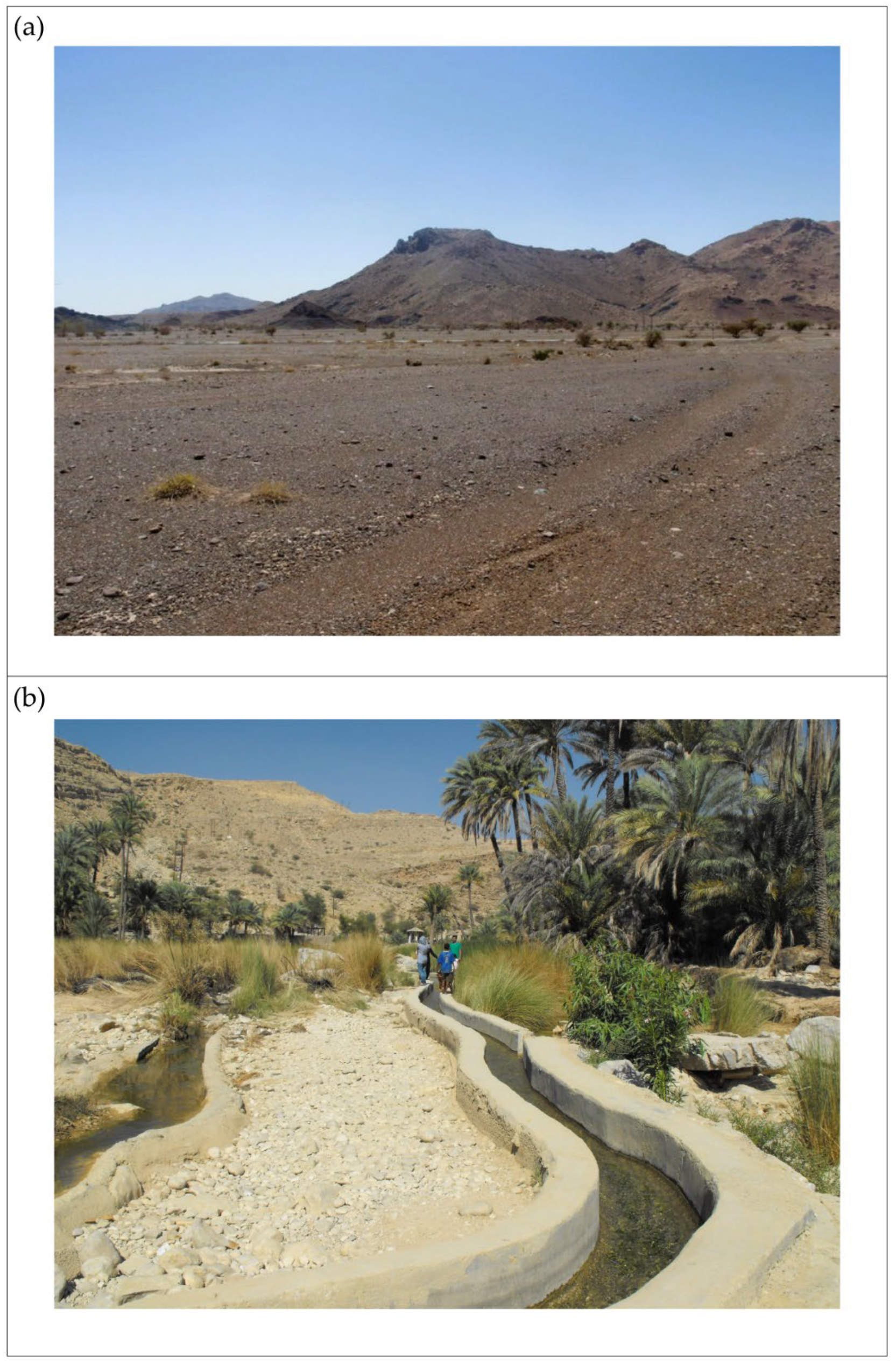
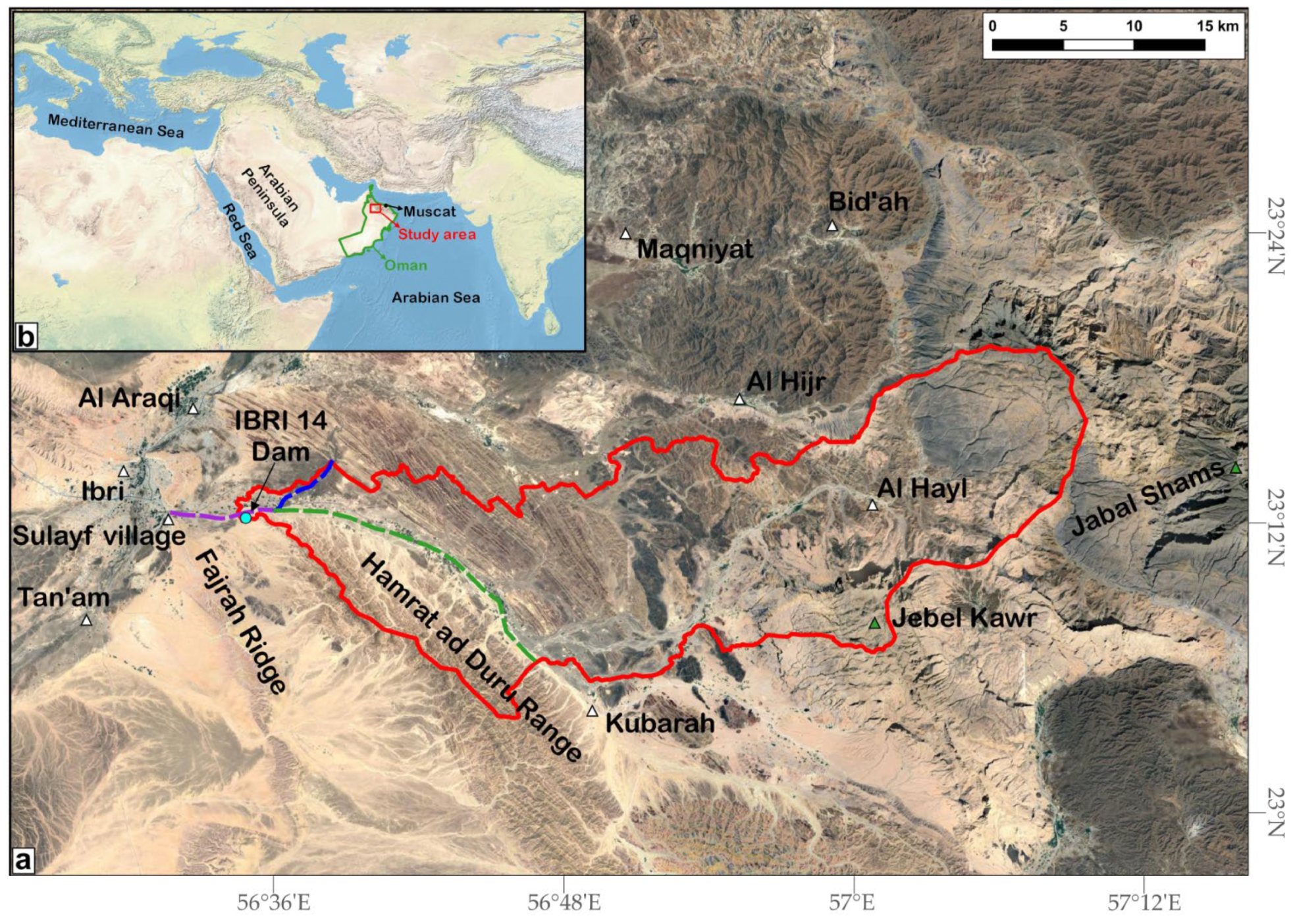
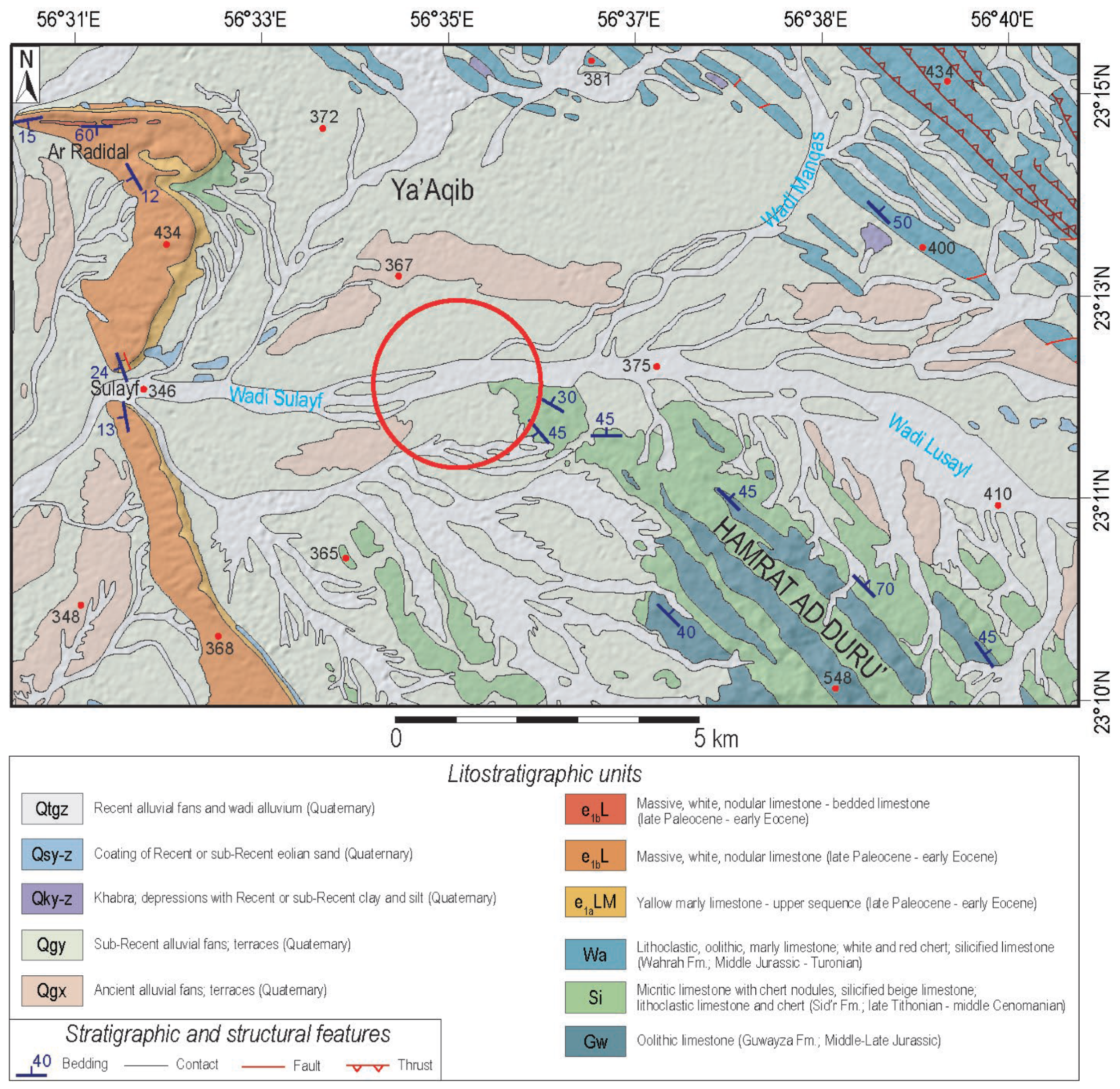
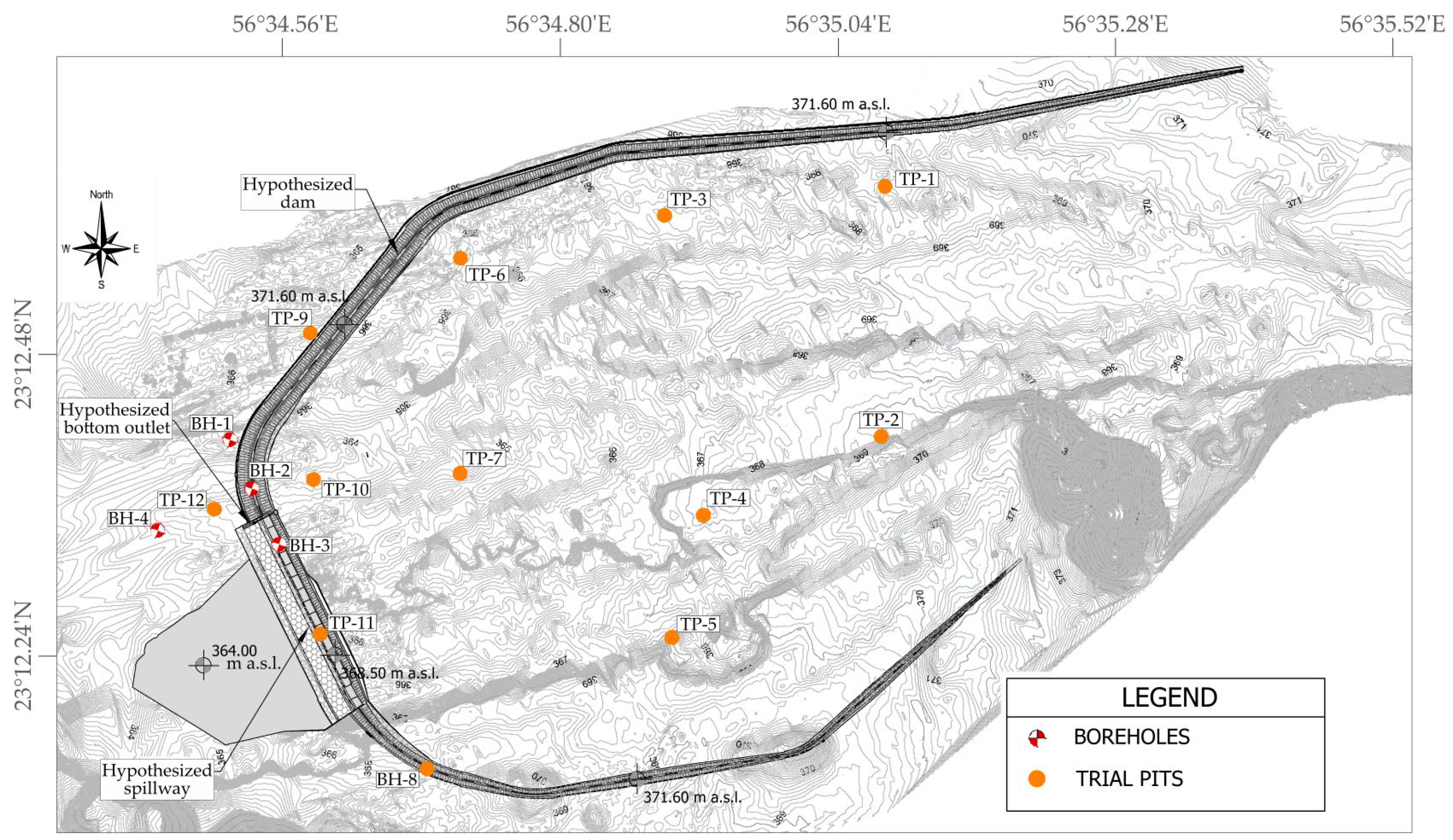
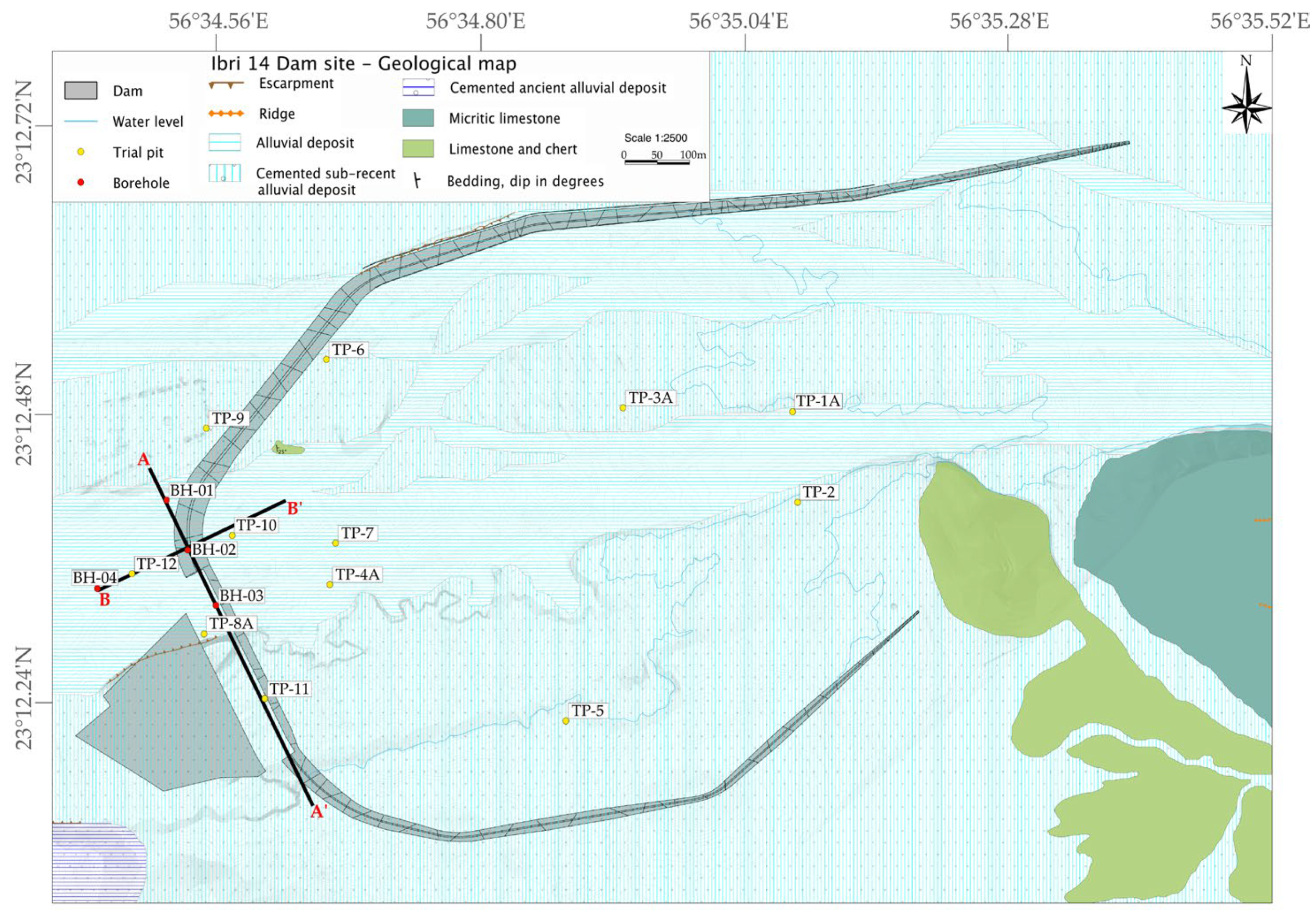
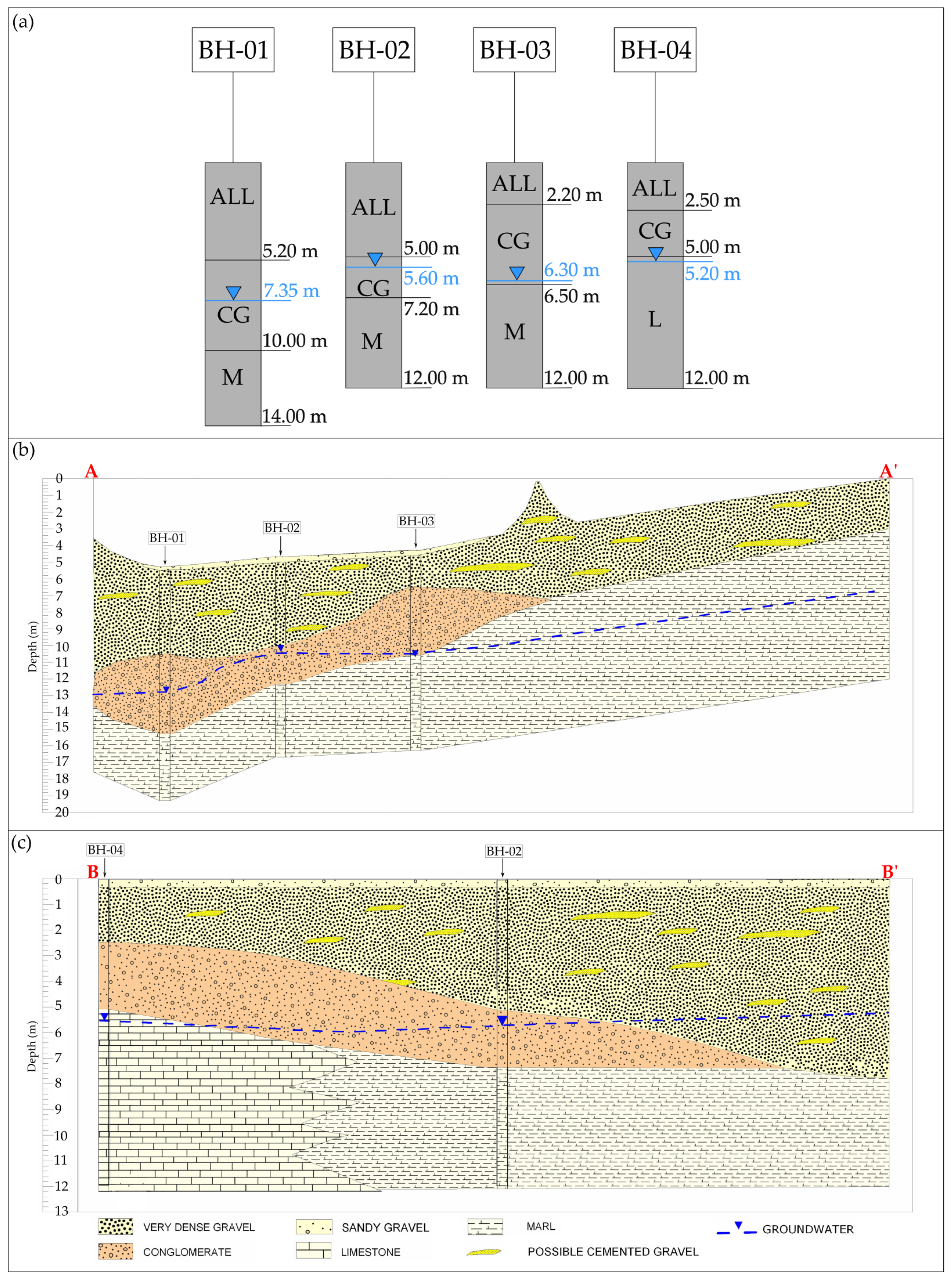
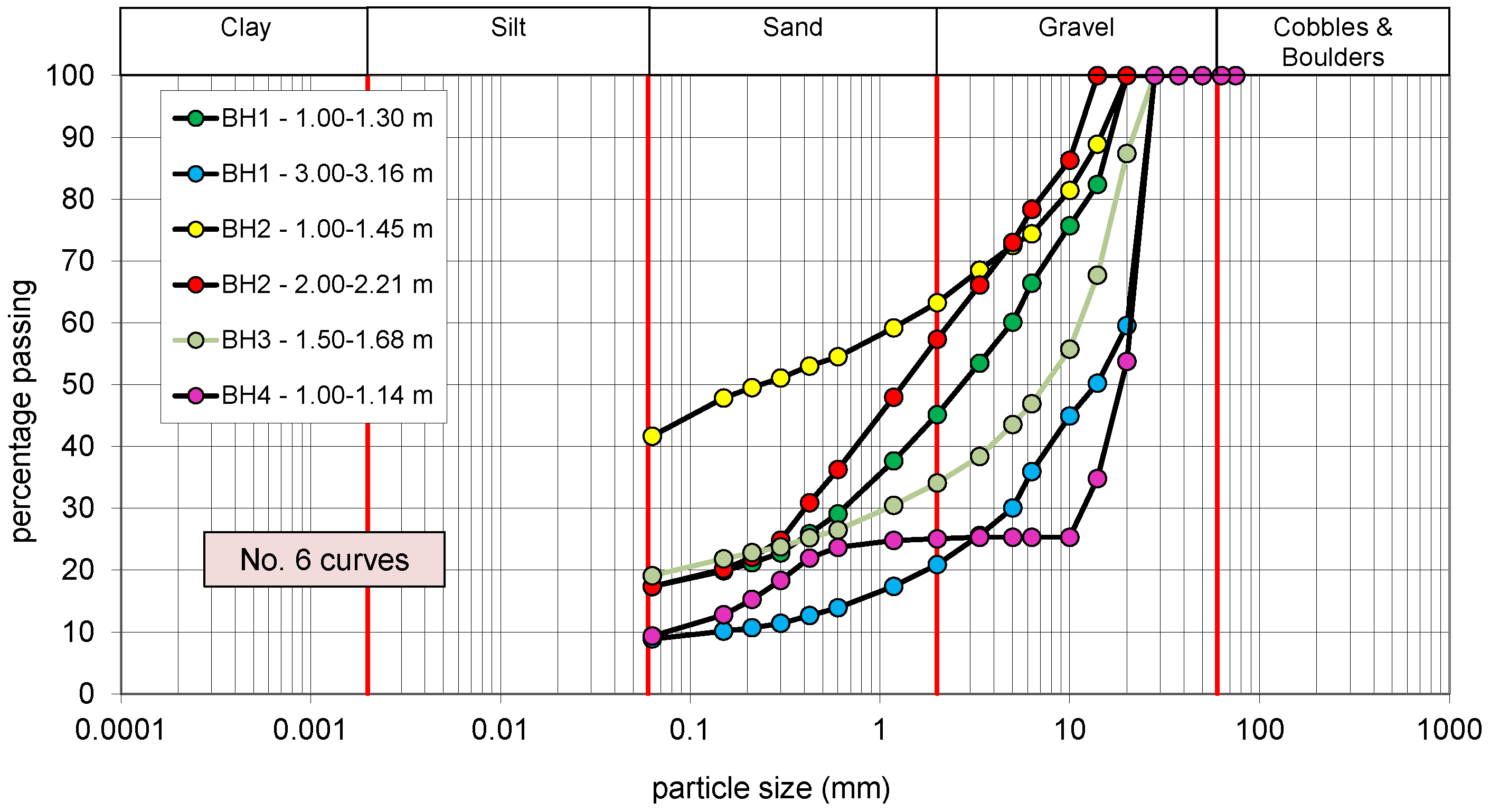

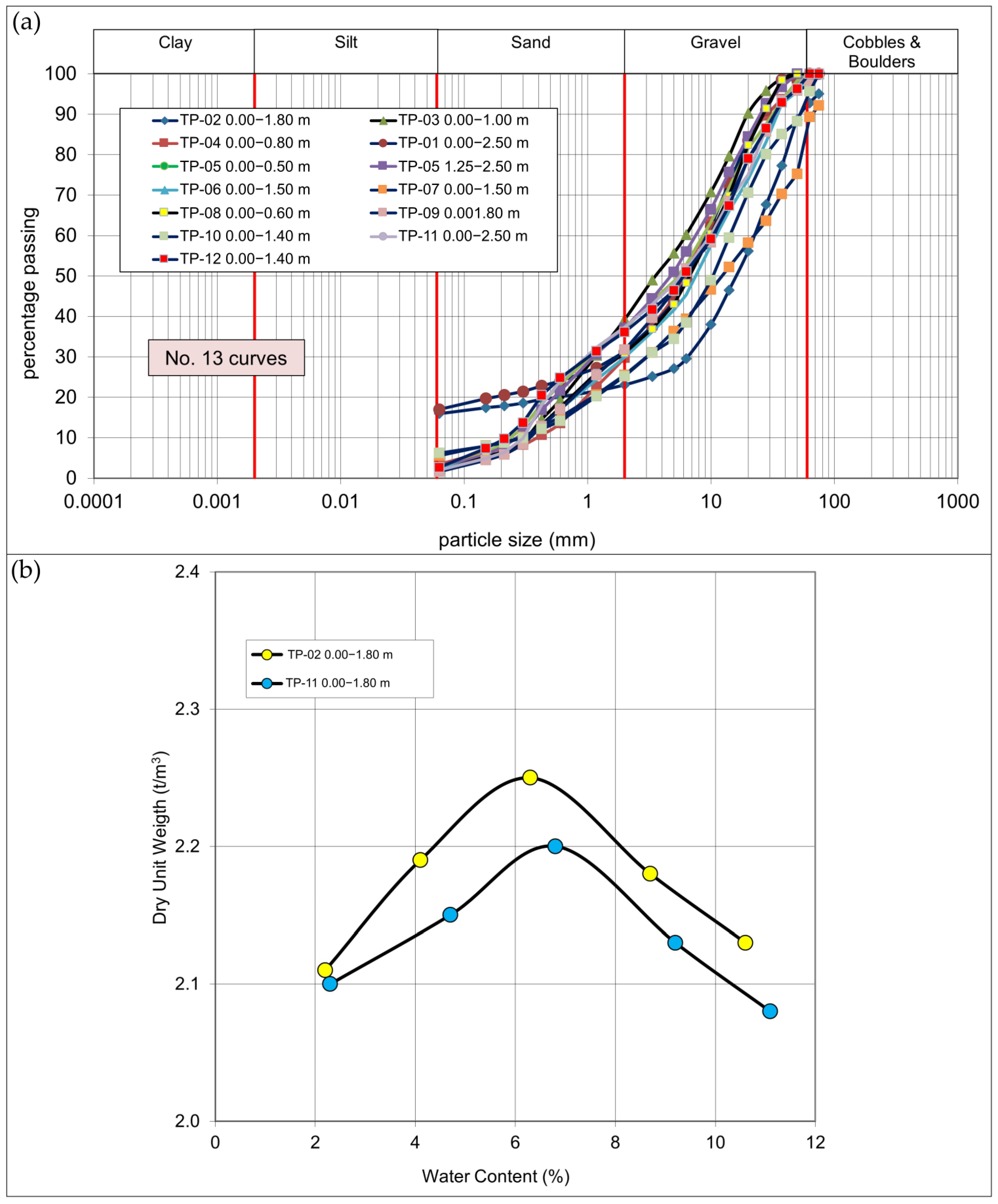



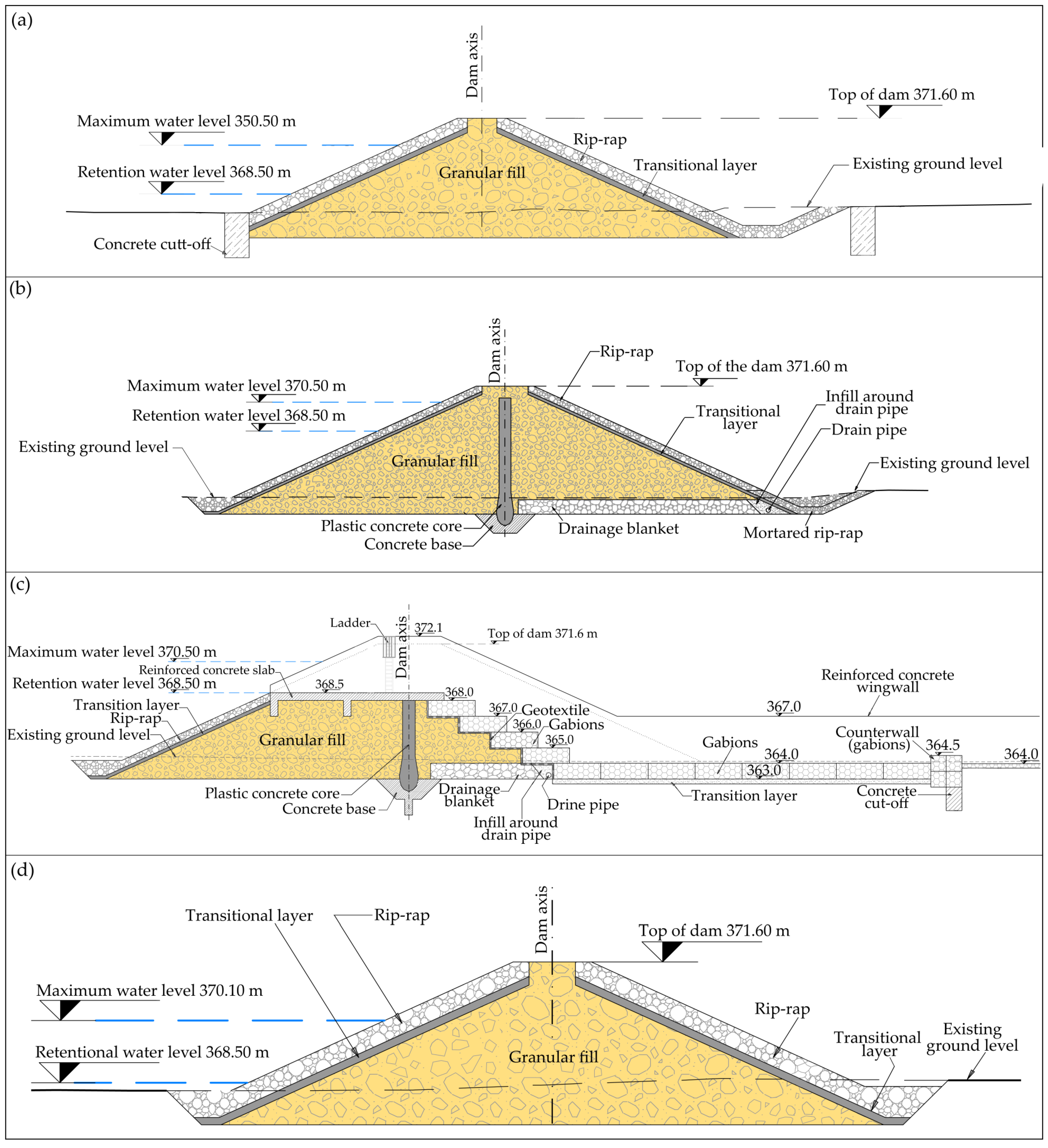
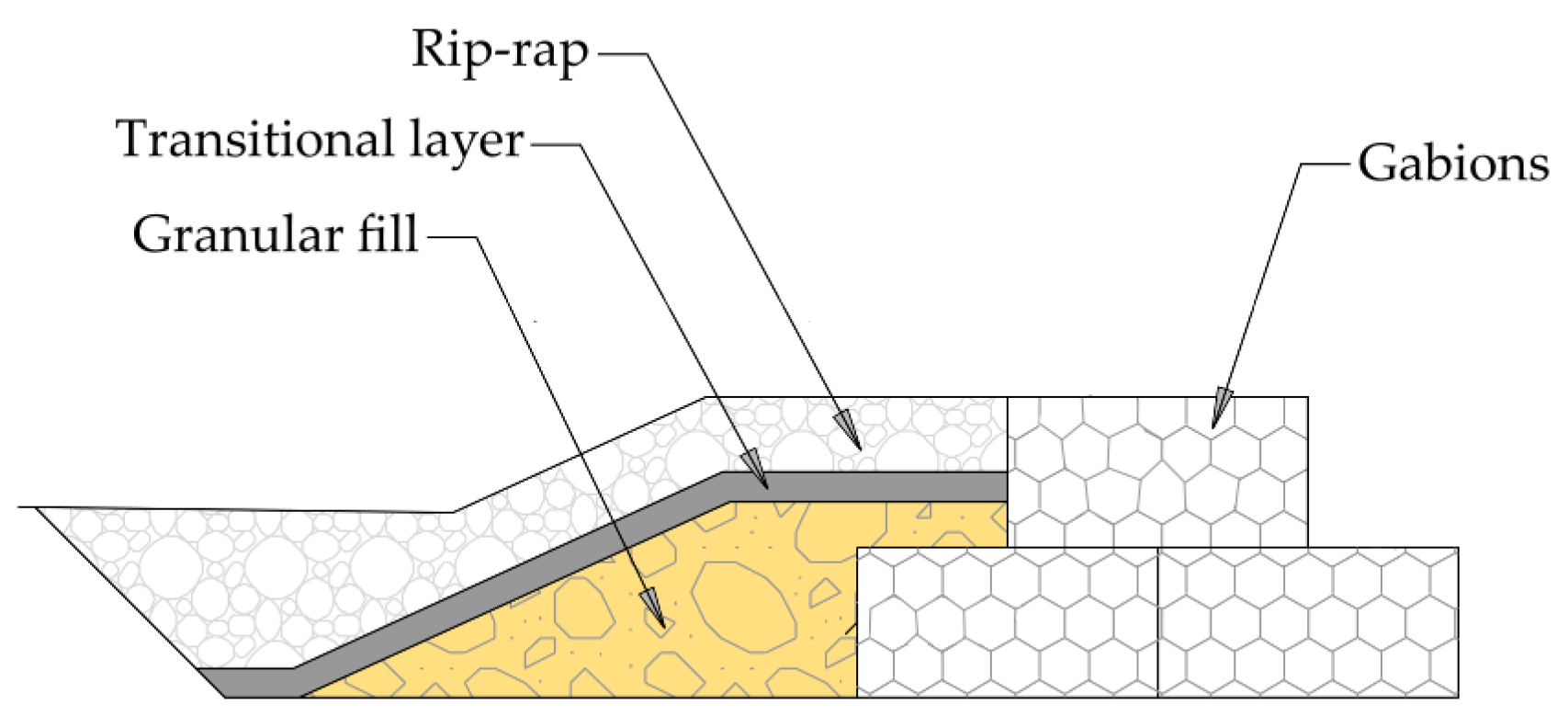
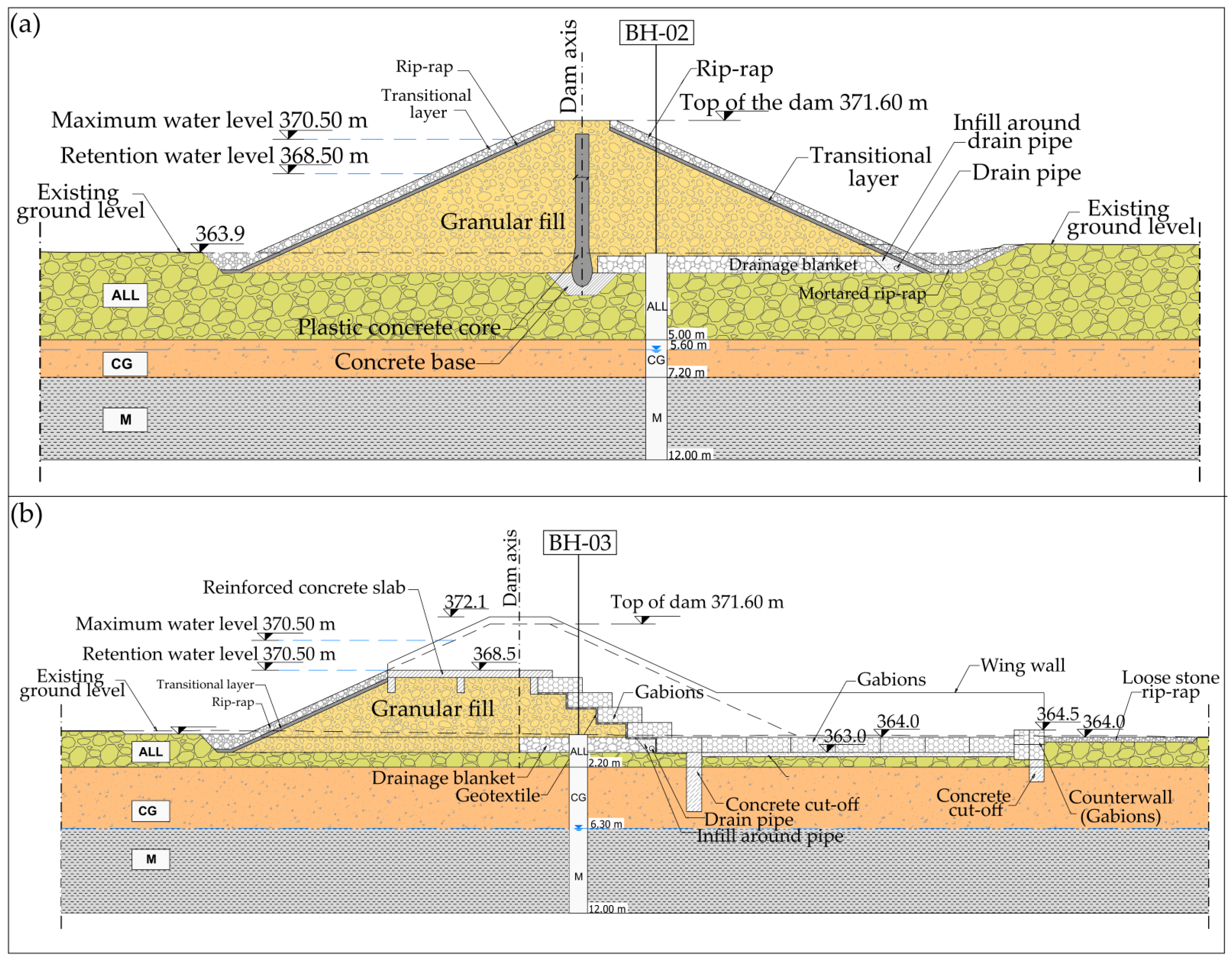
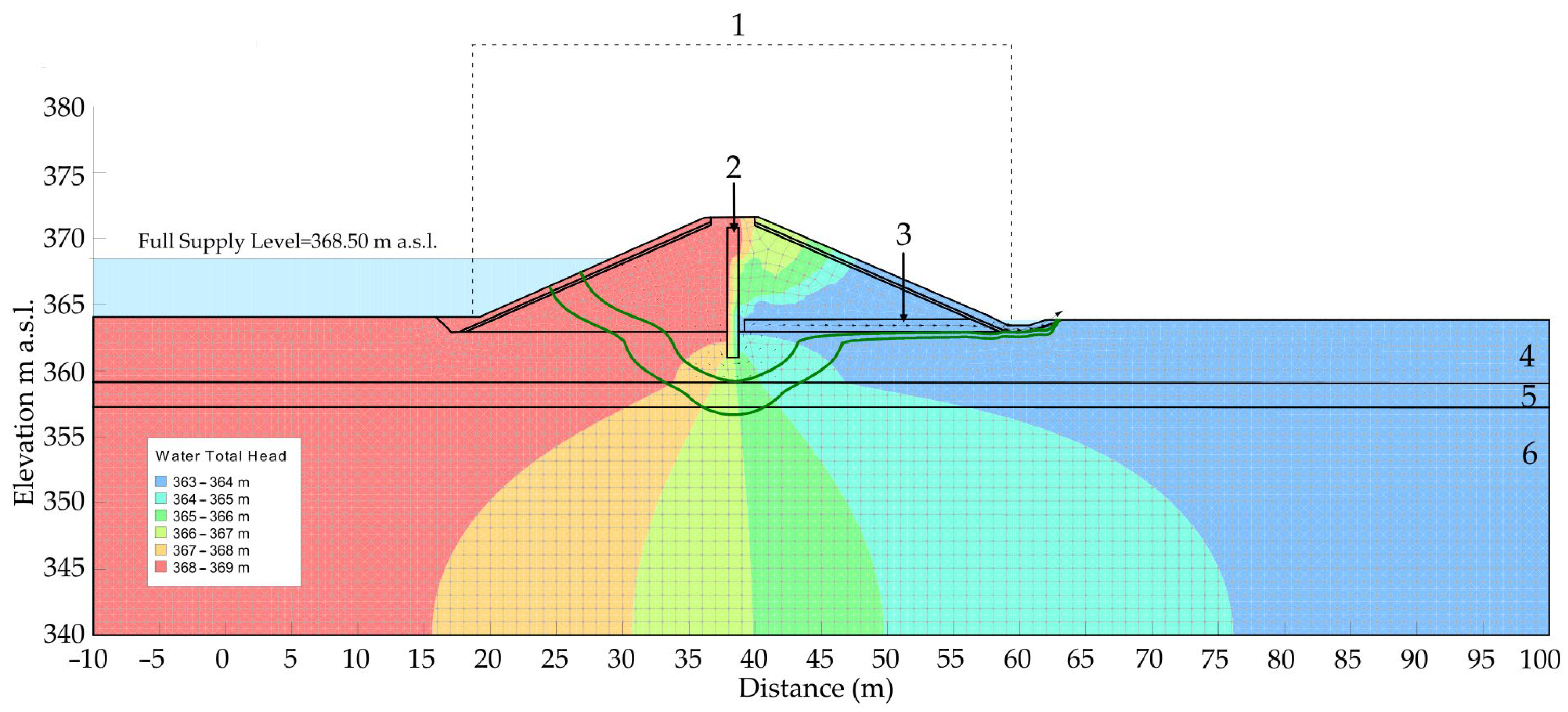
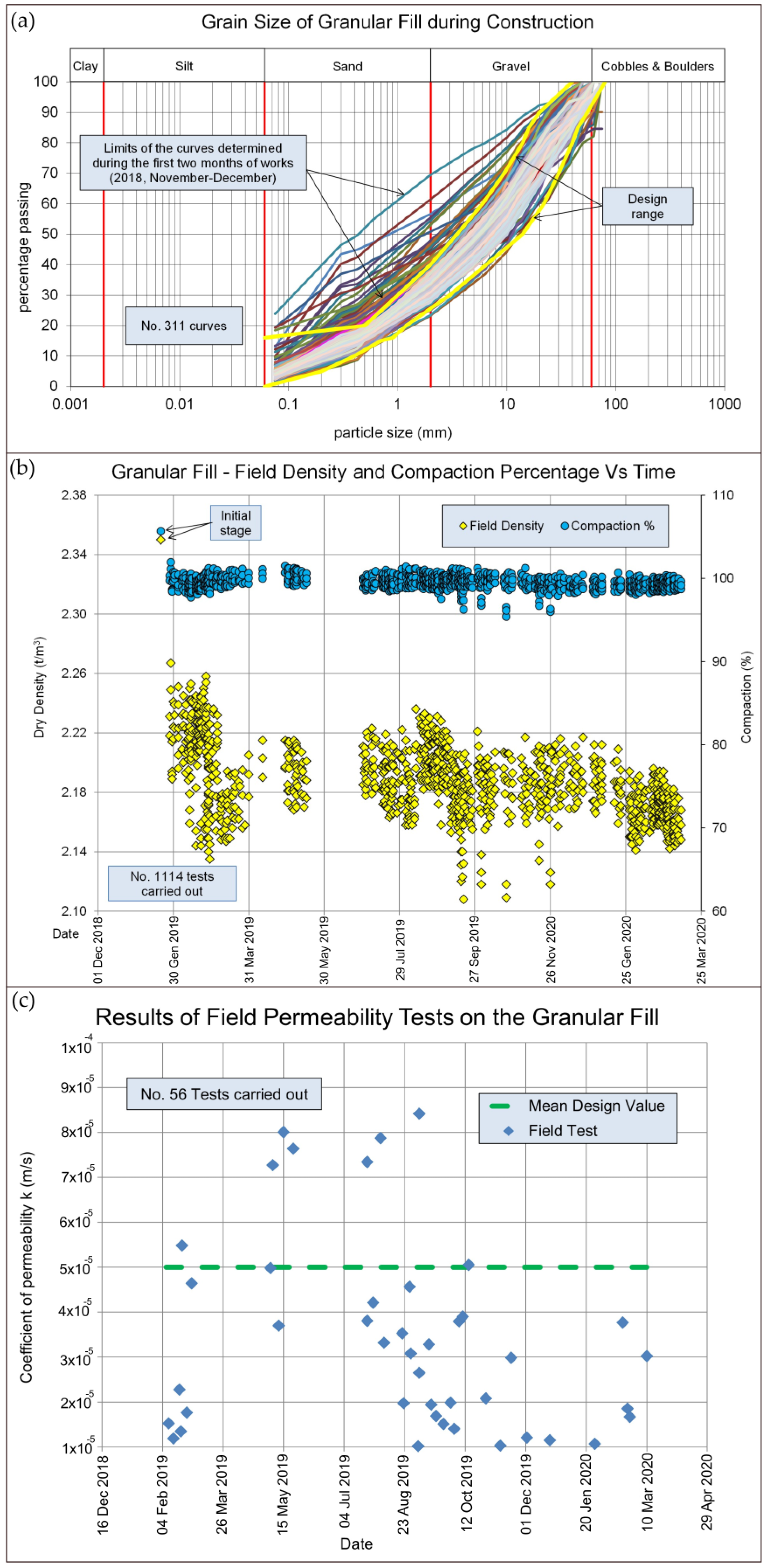
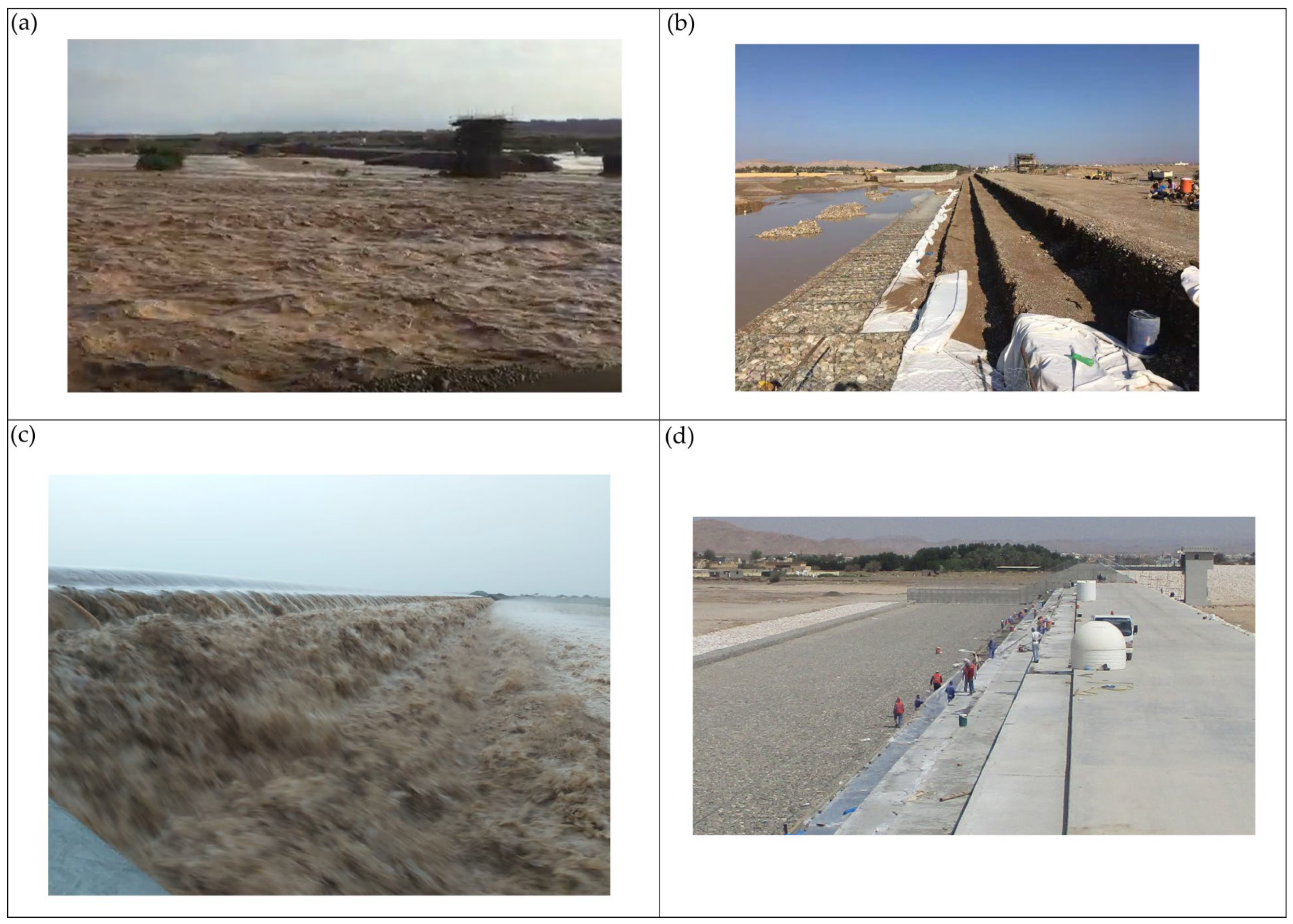

| Borehole | Depth [m] | NSPT | DR (%) | φ (°) | E’s | Vs [m/s] | G [m/s] |
|---|---|---|---|---|---|---|---|
| BH-01 | 1.00 | 50 | 100 | 46 | 73 | 262 | 112 |
| BH-01 | 4.14 | 50 | 100 | 46 | 58 | 329 | 176 |
| BH-02 | 1.00 | 37 | 100 | 46 | 48 | 235 | 90 |
| BH-02 | 2.00 | 50 | 100 | 46 | 58 | 284 | 132 |
| BH-03 | 1.50 | 50 | 100 | 46 | 58 | 268 | 118 |
| BH-04 | 1.00 | 50 | 100 | 46 | 58 | 248 | 100 |
| BH-04 | 3.00 | 32 | 92 | 45 | 44 | 286 | 133 |
| Soil | Unit Weight γ (kN/m3) | Cohesion c’ (kPa) | Friction Angle φ’ (°) |
|---|---|---|---|
| Alluvial Deposits | 21 | 0 | 35 |
| Conglomerate | 21 | 50 | 30 |
| Marl/Limestone | 20 | 15 | 28 |
| Granular Fill | 21 | 0 | 40 |
| Riprap | 23 | 0 | 45 |
| Drainage Blanket | 21 | 0 | 42 |
| Case | Dam Elevations (m a.s.l.) | Maximum Discharge (m3/s/m) | Maximum Vertical Exit Gradient | ||
|---|---|---|---|---|---|
| Crest | Toe | Reservoir | |||
| (a) Embankment at Maximum Height | 371.60 | 363.85 | 368.50 | 2.6 E-005 | 0.19 |
| (b) Spillway at Maximum Height | 368.50 | 363.85 | 368.50 | 7 E-006 | 0.10 |
| Load Case | Side of the Dam | Reservoir Level [m a.s.l.] | kh | kv | Fs | F (Case “a”) | F (Case “b”) |
|---|---|---|---|---|---|---|---|
| EoC: End of Construction | Upstream | Empty | 0 | 0 | 1.3 | 1.50 | 1.79 |
| Downstream | Empty | 0 | 0 | 1.3 | 1.53 | 1.40 | |
| FSL: Full supply level | Upstream | 368.50 | 0 | 0 | 1.3 | 1.45 | 1.45 |
| MWL: Maximum Water Level—Extreme Case | Upstream | 370.50 | 0 | 0 | 1.1 | 1.43 | 1.42 |
| RDD: Rapid Drawdown | Upstream | Empty with water in the embankment | 0 | 0 | 1.1 | 1.15 | 1.17 |
| OBE: Operating Basis Earthquake | Upstream | Empty | 0.04 | −0.02 | 1.3 | 1.33 | 1.61 |
| Downstream | Empty | 0.04 | −0.02 | 1.3 | 1.38 | 1.40 | |
| OBE + Water Level at FSL | Upstream | 140.00 | 0.04 | −0.02 | 1.1 | 1.19 | 1.19 |
| MCE: Maximum Credible Earthquake | Upstream | Empty | 0.07 | −0.035 | 1.0 | 1.25 | 1.49 |
| Downstream | Empty | 0.07 | −0.035 | 1.0 | 1.27 | 1.21 |
| Maximum Dam Height H (m) | Alignment Length (m) | Maximum Water Level RWL (m a.s.l.) | Retention Water Level MWL (m a.s.l.) | Dam Crest Level (m a.s.l.) | Freeboard (m) | Crest Width (m) | Total Volume of the Dam (m3) |
|---|---|---|---|---|---|---|---|
| 7.7 | 3192 | 368.50 | 368.50 | 371.60 | 1.5 | 2.0–4.0 | 192,678 |
Disclaimer/Publisher’s Note: The statements, opinions and data contained in all publications are solely those of the individual author(s) and contributor(s) and not of MDPI and/or the editor(s). MDPI and/or the editor(s) disclaim responsibility for any injury to people or property resulting from any ideas, methods, instructions or products referred to in the content. |
© 2025 by the authors. Licensee MDPI, Basel, Switzerland. This article is an open access article distributed under the terms and conditions of the Creative Commons Attribution (CC BY) license (https://creativecommons.org/licenses/by/4.0/).
Share and Cite
Canzoneri, V.; Bonfardeci, A.; Bongiovanni, S.; Coletta, L.; Curcuruto, E.P.; Gasparo Morticelli, M.; Sulli, A.; Canzoneri, A. Geological and Geotechnical Studies Aimed at the Project and Construction of Rockfill Recharge Dams: The Case Study of the Wadi Sulayf Dam, Wilayat Ibri Region, Oman. Geotechnics 2025, 5, 74. https://doi.org/10.3390/geotechnics5040074
Canzoneri V, Bonfardeci A, Bongiovanni S, Coletta L, Curcuruto EP, Gasparo Morticelli M, Sulli A, Canzoneri A. Geological and Geotechnical Studies Aimed at the Project and Construction of Rockfill Recharge Dams: The Case Study of the Wadi Sulayf Dam, Wilayat Ibri Region, Oman. Geotechnics. 2025; 5(4):74. https://doi.org/10.3390/geotechnics5040074
Chicago/Turabian StyleCanzoneri, Vincenzo, Alessandro Bonfardeci, Simona Bongiovanni, Lavinia Coletta, Enrico Paolo Curcuruto, Maurizio Gasparo Morticelli, Attilio Sulli, and Alessandro Canzoneri. 2025. "Geological and Geotechnical Studies Aimed at the Project and Construction of Rockfill Recharge Dams: The Case Study of the Wadi Sulayf Dam, Wilayat Ibri Region, Oman" Geotechnics 5, no. 4: 74. https://doi.org/10.3390/geotechnics5040074
APA StyleCanzoneri, V., Bonfardeci, A., Bongiovanni, S., Coletta, L., Curcuruto, E. P., Gasparo Morticelli, M., Sulli, A., & Canzoneri, A. (2025). Geological and Geotechnical Studies Aimed at the Project and Construction of Rockfill Recharge Dams: The Case Study of the Wadi Sulayf Dam, Wilayat Ibri Region, Oman. Geotechnics, 5(4), 74. https://doi.org/10.3390/geotechnics5040074






